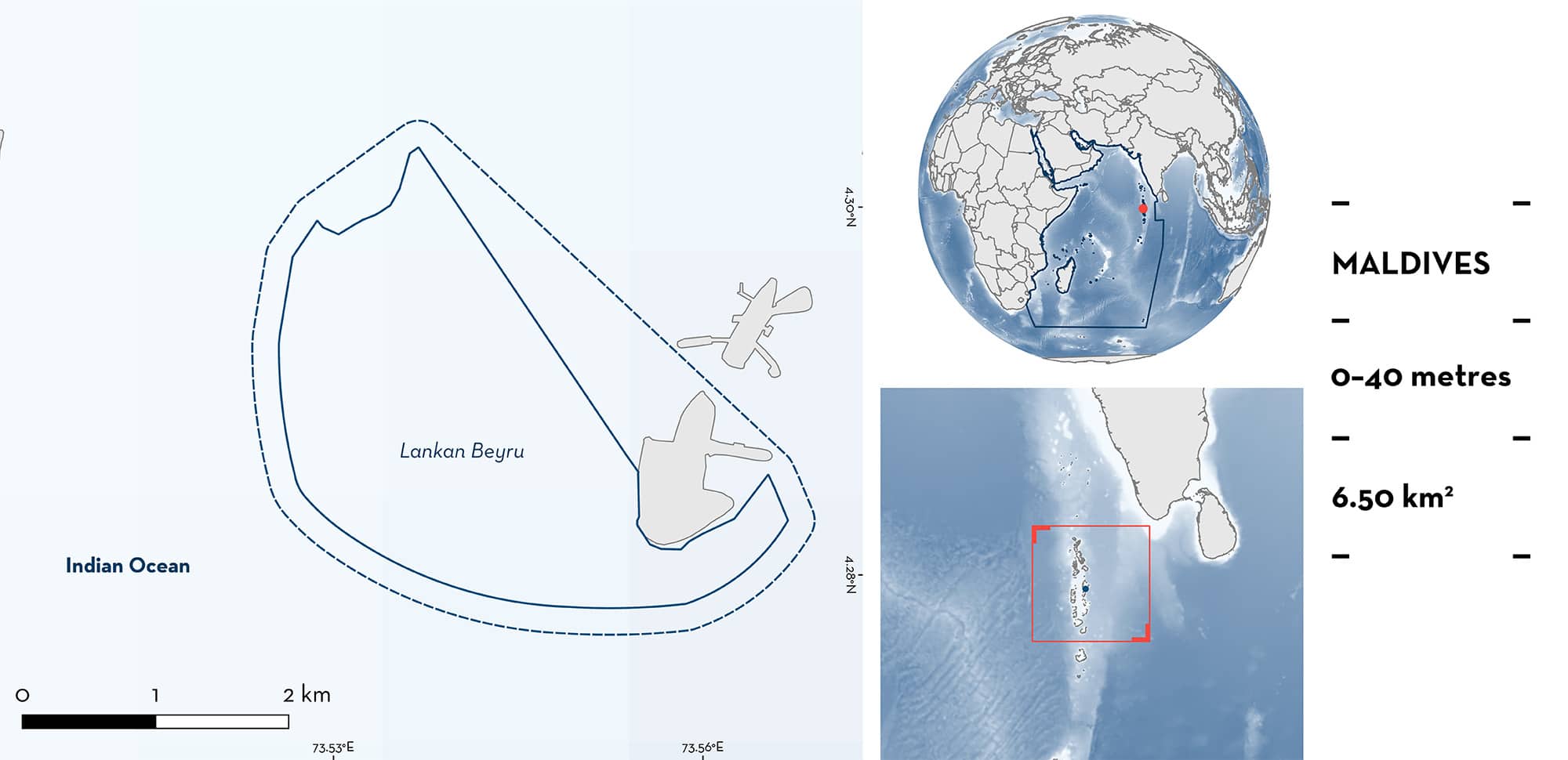ISRA FACTSHEETS
ISRA FACTSHEETS
WESTERN INDIAN OCEAN REGION
Lankan Beyru
Summary
Lankan Beyru is situated on the outer side of Lankanfushi island in eastern North Malé Atoll in the northern-central Maldives. This area is composed of three main sites: Lankan Beyru, Nassimo Thila, and Sunlight Faru. The area is characterised by a sloping coral reef that runs between channels, a series of flat, layered coral tables, a lagoon, and a pinnacle reef, where the reef top is shallow but remains completely submerged. This area partially overlaps with a marine protected area. Within this area there are: threatened species (e.g., Whitetip Reef Shark Triaenodon obesus); reproductive areas (Reef Manta Ray Mobula alfredi); and undefined aggregations (Whitetip Reef Shark).
Download factsheet
Lankan Beyru
DESCRIPTION OF HABITAT
Lankan Beyru is located in the northern-central Maldives archipelago which sits centrally upon the Chagos-Laccadive Ridge (Stevens & Froman 2019). This area is composed by three main sites (Lankan Beyru, Nassimo Thila, and Sunlight Faru) located on the outer side of Lankanfushi island in eastern North Malé Atoll.
Lankan Beyru site is a sloping coral reef that runs between channels on either side of Lankanfushi Island (Godfrey 2018). It is ~400 m long and the top reef sits at ~5 m depth and slopes gradually down to ~30 m at the deepest point. At ~12 metres depth there is a series of flat, layered coral tables (Godfrey 2018). Nassimo Thila (also known as Lankan Thila or Manta Point) sits inside North Malé Atoll and reaches a depth of ~20 m at the deepest point. Thilas are the local names for underwater pinnacle reefs, where the top reef is shallow but remains completely submerged even during high tides (Stevens & Froman 2019). Sunlight Faru is a sandy lagoon area with scatterings of coral heads on the sea floor at a depth of ~18 m (Godfrey 2018).
The weather in the Maldives is strongly influenced by the South Asian monsoon, especially the northern and central atolls as these are closer to the Indian subcontinent (Anderson et al. 2011). Therefore, two monsoons occur annually in Maldives. The southwest monsoon (locally known as Hulhan’gu), from May to November, and the Northeast monsoon (locally known as Iruvai), from January to March, with transitional periods in December and April (Shankar et al. 2002; Anderson et al. 2011). The southwest monsoon increases average rainfall, and wind speeds, causing rougher seas and reduced visibility; in contrast, the northeast monsoon usually brings clear waters (Stevens & Froman 2019).
The Maldives archipelago disrupts the flow of the monsoon-driven North Equatorial Current as it crosses the Indian Ocean (Schott & McCreary 2001) which creates a current flow through the Maldives’ channels (Sasamal 2006). The strongest lunar currents can overcome the prevailing monsoonal currents through the tidal suction mechanism along the channel’s outer edges (Stevens 2016).
This Important Shark and Ray Area is benthopelagic and is delineated from inshore and surface waters (0 m) to 40 m based on the bathymetry of the area.
CRITERION A
VULNERABILITY
Two Qualifying Species considered threatened with extinction according to the IUCN Red List of Threatened SpeciesTM regularly occur in the area. These are the Vulnerable Whitetip Reef Shark (Simpfendorfer et al. 2020) and Reef Manta Ray (Marshall et al. 2022).
CRITERION C
SUB-CRITERION C1 – REPRODUCTIVE AREAS
Lankan Beyru is an important reproductive area for one ray species.
Data collected between 2007–2022 revealed that 5.2% (n = 334) of all Reef Manta Ray sightings (n = 6,361) were of courtship behaviour. The behaviour was observed in 179 Reef Manta Rays and included shadowing and mating chains (IDtheManta unpubl. data 2007–2022). Reef Manta Ray courtship and mating behaviour has been studied over a 14-year period (2003–2016) showing photographic evidence of this behavior (Stevens et al. 2018). Lankan Beyru had the highest number of courtship events (n = 62) in the Maldives, based on 11,000 surveys undertaken at known Reef Manta Ray aggregation sites across the archipelago (22 atolls across 265 different sites). Also, 469 pregnant females have been observed, 290 of which were in near-term pregnancy (i.e., fourth trimester) (IDtheManta unpubl. data 2007–2022). Females are determined to be pregnant by the presence of extended abdomens by trained researchers as described by Stevens (2016). These can establish the trimester using the size of the rounded belly through sight. Also using photo-identification, the pregnancy periods can be tracked for re-sighted Reef Manta Rays. Pregnancy in Reef Manta Rays has been verified in 2018-2019 using contactless ultrasound scanning in other sites of the Maldives (Froman et al. 2023).
CRITERION C
SUB-CRITERION C5 – UNDEFINED AGGREGATIONS
Lankan Beyru is an important aggregation area for one shark species.
For Whitetip Reef Sharks, data were collected from a citizen-science program known as the Sharkwatch project which was a government-led initiative between 2009–2019 (Maldives Marine Research Institute [MMRI], unpubl. data 2023). Data were collected by experienced dive guides using the roving diver technique where surveyors can swim in any direction and count the number of individuals encountered by species during 1-hour dive survey. From the ~1,110 sites surveyed in the Maldives, this area has been identified as one of the most important aggregations for the Whitetip Reef Shark (MMRI unpubl. data 2023). Sharkwatch surveys were conducted over eight years (2009–2017; n = 1,698) in this area.
Download factsheet
SUBMIT A REQUEST
ISRA SPATIAL LAYER REQUEST
To make a request to download the ISRA Layer in either a GIS compatible Shapefile (.shp) or Google Earth compatible Keyhole Markup Language Zipped file (.kmz) please complete the following form. We will review your request and send the download details to you. We will endeavor to send you the requested files as soon as we can. However, please note that this is not an automated process, and before requests are responded to, they undergo internal review and authorization. As such, requests normally take 5–10 working days to process.
Should you have questions about the data or process, please do not hesitate to contact us.


